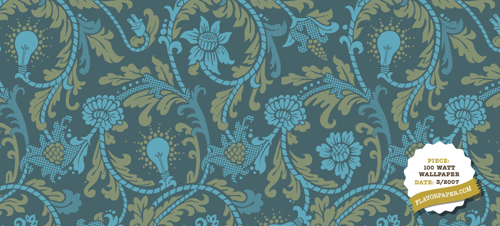40+ Excellent Freefonts
By student demand, here is a link to the article at SmashingMagazine.com entitled 40+ Excellent Freefonts For Professional Design. (ATTENTION STUDENTS: Please choose and use these fonts with care. There are some good typefaces here, and perhaps some great ones, but I think the word ‘excellent’ in this context may be a slang appeal to youth culture, or the youth market, and does not necessarily connote excellence in the classic typographic sense of preeminence. In other words, you may have to pay for your preeminent fonts.) (Thank you Bryan Briggs.)
unusual wallpapers and repeats

Dan Funderburgh makes unusual wallpapers and repeats.
skyblue and smokedsalmon and mustardyellow
“A small bearded bandylegged man in a derby walked up Allen Street, up the sunstriped tunnel hung with skyblue and smokedsalmon and mustardyellow quilts, littered with second hand gingerbread-colored furniture.”
—John Dos Passos, Manhattan Transfer, 1925.
tinfoil stairs
“The cabin boy lay on his back looking at the clouds. They floated from the west, great piled edifices with the sunlight crashing through between, bright an white like tinfoil. He was walking through tall white highpiled streets, stalking in a frock coat with a tall white collar up tinfoil stairs, broad, cleanswept, through blue portals into streaky marble halls where money rustled and clinked on long tinfoil tables, banknotes, silver, gold.”
—John Dos Passos, Manhattan Transfer, 1925.
a green hand
“‘Thought I could git a work as a longshoreman, ma’am, but they’re layin’ men off down on the wharves. Mebbe I kin go to sea as a sailor but nobody wants a green hand. . . .’”
—John Dos Passos, Manhattan Transfer, 1925.
his mauve and lavender portfolio
“He pulled out letters and memoranda at random from his collection . . . ‘I’ll read you one among many’ . . .
He kept all these admiring letters in his mauve and lavender portfolio.”
—Louis-Ferdinand Céline, Death on the Installment Plan, translated by Ralph Manheim, 1966.
her dingat
“Right away Antoine pushed the fat mama down on her knees . . . He was awfully brutal . . . She had her ass up in the air . . . He tickled and teased her . . . He couldn’t find her dingat . . . He tore her ruffles . . . he tore everything in sight . . .”
—Louis-Ferdinand Céline, Death on the Installment Plan, translated by Ralph Manheim, 1966.
every imaginable color
“The bathers crowd around, all hysterical . . . The raging sea pounds me down to the bottom, then lifts me gasping to the surface . . . In a flashing moment I see that they’re discussing my agony . . . There they are, every imaginable color: green . . . blue, parasols, lavender ones, lemon-yellow ones . . . I whirl about in pieces . . . And then I don’t see a thing . . .”
—Louis-Ferdinand Céline, Death on the Installment Plan, translated by Ralph Manheim, 1966.
[T]he universe that we know
“[T]he universe that we know is immensely large and complex. Its extension in time and space is beyond human scale and comprehension. The universe is 15 billion years old; our sun is 4.5 billion years old. In contrast, our human species appeared only 130,000 years ago and the first cave paintings only 35,000–50,000 years ago. The numbers alone enforce both a sense of perspective and humility. Humbling, too, is the knowledge that we are intimately connected with the universe ‘all the way up and all the way down,’ because we know that chemically and biologically we share a common ancestry with both the stars and the simplest life forms.”
—Dennis Ford, The Search for Meaning: A Short History, 2007.
the principle of alphabetic writing
“[T]rue alphabetic writing consists in having a sign for each sound (technically each phoneme) of the language, rather than one for each word or one for each syllable. This is the most efficient writing system possible, since a language will be found to have some thousands of words and at least a couple of hundred different syllables, but the words and syllables are made up of individual speech sounds which seldom exceed sixty to seventy in number, and sometimes number as few as a dozen. Hence an alphabetic writing system can, with the fewest possible units . . . record every possible utterance in the language.”
—John P. Hughes, The Science of Language, 1962.